ceramics
Archived Posts from this Category
Archived Posts from this Category
Posted by ben on 10 Feb 2010 | Tagged as: ceramics, responses/reviews
The best show Blue Star has mounted since Lonely Are the Brave is closing this Saturday, and it’s well worth checking out on your way to Second Saturday down the street on S Flores. Familiar Unknown: Contemporary Ceramics takes advantage of Blue Star’s large main exhibition spaces to highlight four women working at the forefront of clay art. It’s another example of ceramics becoming an increasingly visible medium in the San Antonio contemporary gallery scene, something I hope to cover more soon. Curated by Ovidio Giberga, an accomplished ceramic artist in his own right, and director of UTSA’s ceramics program, the show is full of strong work, installed impeccably.
Anne Drew Potter’s disfigured characters laugh and scowl devilishly in installations that are both spare and overflowing with heavily wrought emotion. Three bulbous women direct their menacing gazes at a frail, limp rabbit doll in “The Judgment of Br’er Rabbit.” A large yellow baby glazed in dense, bright yellow (which I’m told is a reference to Chinese glazes) delights in the misfortune of a large cloth baby who has tumped over. Across the gallery, another pair vaguely mirror these poses: a young, naked girl ecstatic lifts her arms above her as she stands over a young, naked boy fallen back on his elbows, gazing up.
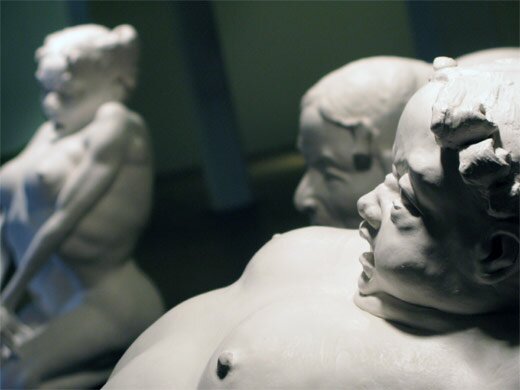
Anne Drew Potter: The Judgment of Br'er Rabbit
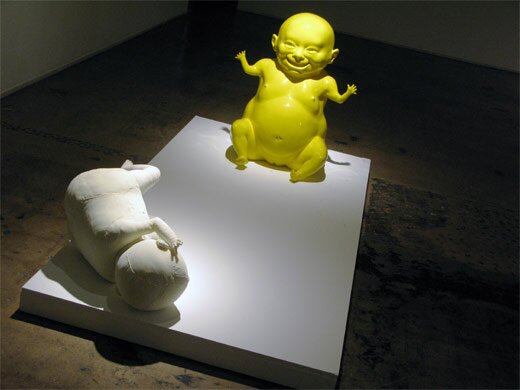
Anne Drew Potter: Big Baby
In the middle of the triangle formed by Potter’s works, an installation by Rebbeca Hutchinson strikes a counterpoint of humble, organic engineering. Apparently built from materials collected on-site, Hutchinson’s spindly sticks with nest-like forms built of paper and clay are scattered sparsely through the space. I feel like I could do a better job describing them if I only knew Japanese, but there’s definitely a healthy dose of wabi in this installation. From the literature, it sounds as if these pieces are destroyed after the exhibit, so I’ll say it again: see this show before it disappears.
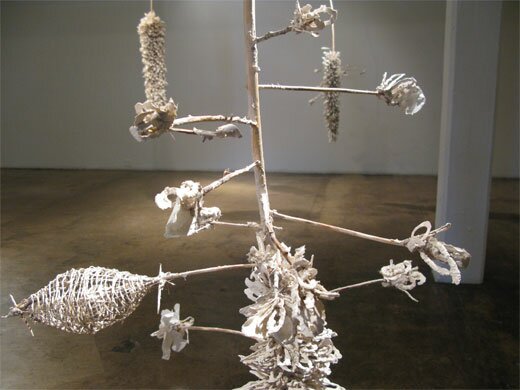
Rebecca Hutchinson Installation
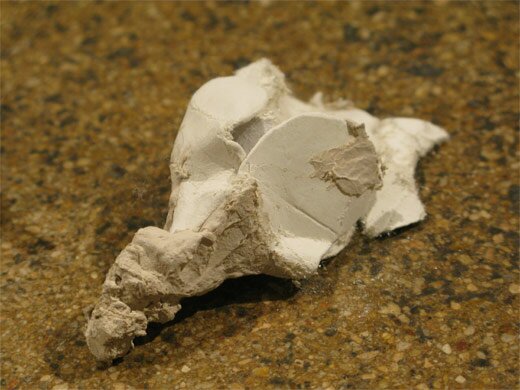
Rebecca Hutchinson Installation
The last installation in the main gallery draws another contrast, with Susan Beiner’s baroque composition of imaginary flowers and and man-made detritus (both exquisitely rendered in porcelain), the only piece that actually hangs on the wall. At first this assemblage appears to consist entirely of flowers and other organic forms, but a close look reveals bolts, pieces of furniture or anonymous industrial objects strewn throughout. Nearby, the flowers growing from the gallery floor make porcelain, foam, and polyfil seem like a most natural combination of materials.
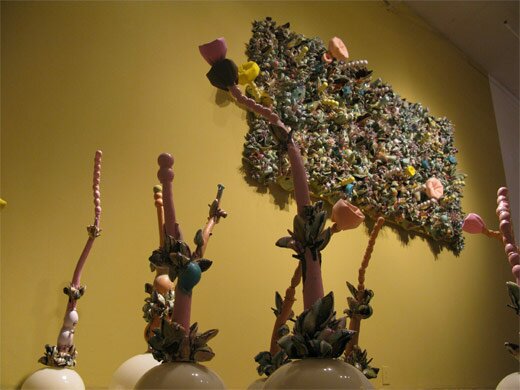
Susan Beiner: Synthetic Stems & Synthetic Reality
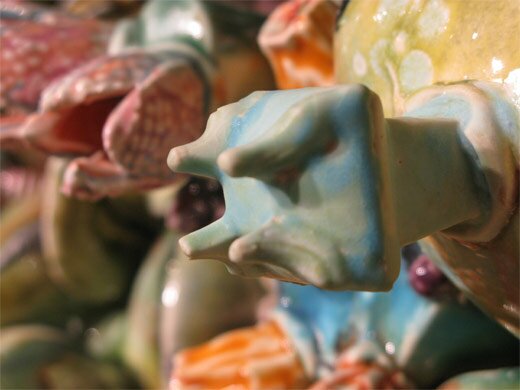
Susan Beiner: Synthetic Stems & Synthetic Reality
Finally, in an adjacent space Blue Star calls the middle gallery, Rebekah Bogard has installed a fantasy world that takes some cues from CGI children’s movies, but sexualizes the characters just a touch. Bright colors and incredibly smooth glazes produce an exhibit that hardly seems ceramic at all. In the artist’s statement, and some other reviews of her work, references to a darkness lurking beneath the candy surface are ubiquitous, but as much as I tried I can’t see it in this installation. It seems very sweet and fluffy to me. Either the artist has moved away from the dark side to some degree, or I’m being naive; judge for yourself.
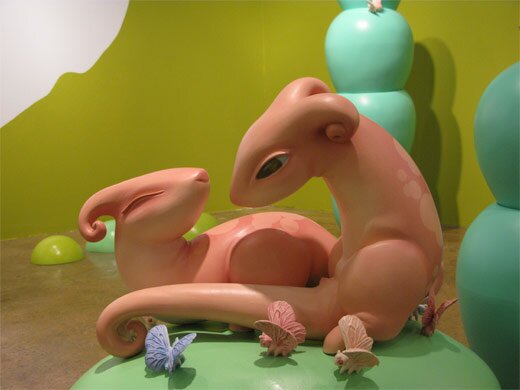
Rebekah Bogard Installation
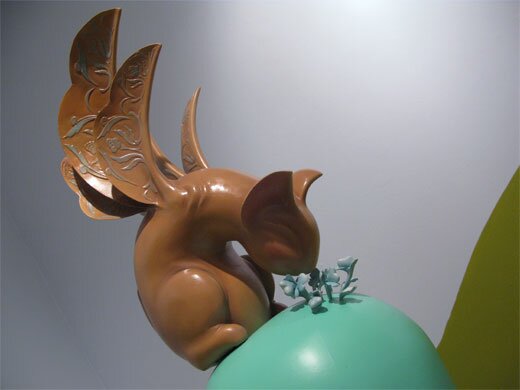
Rebekah Bogard Installation
Posted by ben on 21 Jul 2009 | Tagged as: architecture, ceramics, design, public art
Platform 21 is hyping repair as “the new recycling” with its Repair Manifesto, along with various contests and publicity efforts. It’s interesting that some of the “repairs” Platform 21 is publicizing are not functional or structural, but are really aesthetic in nature.
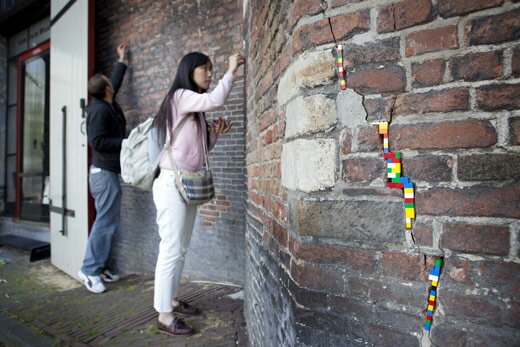
This Jan Vormann project is cool, but it doesn’t appear to offer much in the way of structural integrity. Then again, maybe that’s not the point — highlighting quirky projects like this means more attention for the project, and perhaps a broader reach for the “repair ideology” it is pushing. It also encourages people to think creatively about repair, and makes a chic movement out what often becomes just a greasy time sink. So here’s my contribution: a handmade porcelain teacup I broke and repaired a little while back. It’s not as flashy as Legos in a brick wall, or the “golden seams” of traditional Japanese tea bowl repair, but out of four similar cups, this is now my favorite.
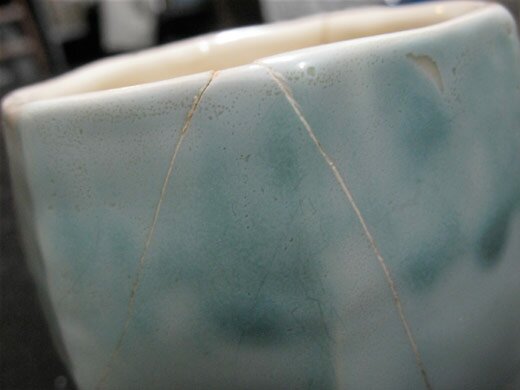
PS. This cup inspired another Emvergeoning post a while back.
Posted by ben on 27 Apr 2008 | Tagged as: ceramics, essays
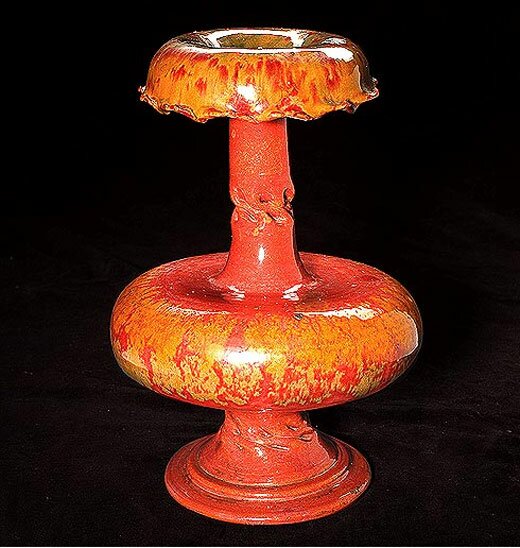
Fountain Vase by George Ohr (ca. 1895-1900)
This afternoon I was skimming over George Brecht’s 1966 essay Chance Imagery; and as I was reading this essay which traces the use of chance techniques in painting back to Kandinsky in 1911, I was drinking water from a handmade porcelain cup given to me by local potter Brad Lum, with its drips of glaze flowing haphazardly down the side. It occurred to me that just around the time that painting began to embrace chance operations, they were being eliminated from ceramics as a result of industrialization. How odd, I thought, that the western artist saw fit to insert chance into a deterministic art form like painting, rather than embrace an essentially chance-based art form like ceramics. Perhaps it is no coincidence that George Ohr is considered by some to be a precursor to the Dada movement in America.
Posted by ben on 27 Feb 2008 | Tagged as: books, ceramics, essays, responses/reviews

This is the first half (or so) of Garth Clark’s Subversive Majesty: Peter Voulkos’ Rocking Pot (included in , his brilliant book on ceramic art):
Rocking Pot is inarguably one of Peter Voulkos’ most inventive and important works. Its strength comes from its intense mixture of ambiguity and ambivalence. Its form is perplexing because it seems familiar; a relative of the domestic pot. Yet its self-penetration of volume and its strange base, made up of two curved feet or “rockers,” sows confusion and challenges its claim to vesselness. It presents itself simultaneously as a pot, a sculpture, and a demented birdfeeder. But Voulkos has no such confusion about the piece. Unequivocally he has stated, “I claim this as a pot.”
That, then, should be the last word on the subject. But in the world of ceramics there is a curious tendency to “upgrade” pots to sculpture when they project the energy of art, as though the pot is too lowly a medium for higher levels of expression. Obviously this is often at the hands of critics who have not spent any time with a Ming vase or a Mimbres bowl. But this elevation to sculpture is meant to be a compliment to the artist (albeit backhanded), and undoubtedly this is what Rose Slivka intended when she described Rocking Pot as “one of Voulkos’s earliest outright sculptures. The pottery technique is evident, while the pottery function is subverted to the formal invention.”
This statement perhaps best reveals the core misunderstanding among the fine arts in the (under) appreciation of the dynamism of pottery. Pots do not cease to be pots when function is subverted. Indeed, for millennia, denying function has been one of humankind’s ways of setting aside certain vessels for a different role, one that perforce became ritualistic and contemplative. Sometimes the act of removing function was profound, as in the Mimbres culture’s practice of putting a hole into the bottom of bowls of the deceased, to allow their souls to escape into the spirit world. This precluded domestic/utilitarian ideas of containment in favor metaphorical containment, in this case a purposeful permeability. In other cases function was obscured rather than denied for reasons of whimsy — to tease the user, as with the so-called puzzle jugs and mugs of the Medieval period.
What supports Voulkos’ insistence that this object be seen as a pot is that it becomes more intriguing when viewed in ceramic terms rather than from a purely sculptural viewpoint. The act of cutting holes into an abstract sculpture is primarily a formal act. Cutting holes into a pot is a violation. It upsets orderly notions of utility and culture. In pottery, volume is a sacred space. Holes deliberately placed by the potter provide entrances and exits. But when punctured in the seemingly destructive and random manner of the Rocking Pot, the vessel can no longer serve its literal purpose of containment. By further skewering the interior of his pot with his curved rockers, Voulkos adds an edge of surreal spatial violence.
Violence against the vessel, however, was not Voulkos’ goal. If the sanctity of the pot has been bruised, it is simply because it has come up against the intense energy and physicality with which the artist imbues his vessels. The holes serve many purposes in this piece. On one level they are drawings in three dimensions (much like Lucio Fontana’s paintings and sculptures from his Concetto Spaziale series). One may even view them more conservatively as pottery decorations in their most abstract form. But they are also spy-holes into the interior architecture of the vessel. They reveal the pot’s powerful inner structure, which those who admire pottery as an art already know exists, but few have seen exposed in so visceral a manner.